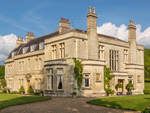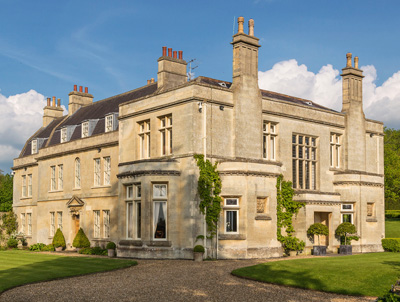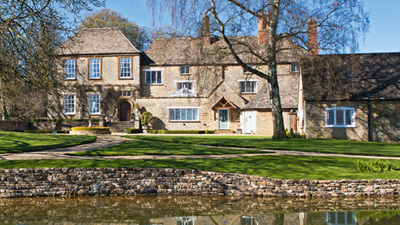Completely restored country houses
These outstanding country properties have been completely renovated, and are ready for buyers to move in


Just as everyone is supposed to have a novel in them, so it's likely most lovers of historic houses probably have a successful renovation project locked away in their psyche somewhere.
But it takes more than enthusiasm and a flair for interior design to see a major restoration through from start to finish, as the vendors of two fine country houses currently on the market will surely testify.
For developer Chris Nicholson and his wife, Jane, a former estate agent, their experience of the property market meant they weren't exactly in unknown territory when, 13 years ago, they embarked on a root-and-branch restoration of rundown, Grade II-listed Beach House in the tiny Cotswold hamlet of Beach in Gloucestershire, five miles from Bath. ‘We had been looking for the right property to renovate for many years, and when, in 1999, Beach House came up for sale following the death of its 94-year-old owner, we jumped at the chance to buy,' says Mrs Nicholson.

Beach House, Savills, £8.25m
The house hadn't been touched in decades. There was no running water -the only water available was from a natural spring-the wiring dated from the 1930s and rain and snow seeped through the roof, which was in dire need of repair. Undaunted, the Nicholsons set about transforming the rambling, 9,770sq ft, late-Georgian farmhouse with its once-grand Victorian extension, its rundown farm buildings and 55 acres of farmland, into the immaculate small country estate that is now on the market through Savills (01225 474500) at a guide price of £8.25 million.
The oldest part of Beach House (the name derives from the beech woods that once surrounded it) was built between 1780 and 1810 by a member of the Whittington family, whose forebear, Richard Whittington, was, famously, thrice Lord Mayor of London.The rest of the Georgian building was completed by about 1840. The original building was significantly altered and extended in the 1880s by paper-mill owner Samuel Evans, whose widow, Elizabeth, remained at Beach House until at least 1921. Their Tudor-inspired Victorian extension on the west side of the house created a series of main reception rooms that were warmer and sunnier than those of the original Georgian house, which is north-facing.
After the Evans era, Beach House reverted to being a farmhouse, and the smallholding was farmed from the 1940s onwards by the Rogers family, who would surely struggle to find their way around the Nicholsons' 21st-century incarnation of Beach House, with its four grand reception rooms, three staircases, 13 fireplaces, spectacular new kitchen/breakfast room and orangery, and four opulent first-floor bedroom suites. A nursery wing, two more family bedrooms, an office and a strongroom are housed on the second floor.
Sign up for the Country Life Newsletter
Exquisite houses, the beauty of Nature, and how to get the most from your life, straight to your inbox.
The once-humble smallholding itself has been transformed into a model farmstead endowed with full organic status, with the added appeal of formal gardens, kitchen gardens, greenhouses, stabling and well-fenced paddocks. There have also been practical improvements, with the conversion of the former coach house to a guest cottage and office suite, that of a complex of original farm buildings to four two-bedroom holiday cottages, and a pair of lodges to two two-bedroom cottages, each with its own garden and garage.

North Aston Manor, Excess £12m, Savills
A similar grasp of the big picture is evident in the case of Grade II listed North Aston Manor at North Aston, near Oxford, which overlooks the picturesque Cherwell valley, and has been the subject of a major four-year renovation programme, completed in 2010. Its owners, who bought the historic manor house 18 years ago, have certainly spared no expense or expertise in refurbishing the house and its 18 acres of gardens, grounds and equestrian facilities to ‘international standards'.
Standards that will surely impress international buyers who ‘generally don't want a project, and when they buy a house, want to move in right away, with everything in place,' says selling agent Oliver Langdale of Savills (01865 339 700), who quotes a guide price of ‘excess £12m' for North Aston Manor. According to its listing, the present manor house dates from the 15th century, when it was owned by the Earl of Salisbury. It was altered and remodelled in the 1600s, when it was owned by the recusant Brooke family.
Three generations of the Bowles family held the estate from 1740 to 1862, when the manor was sold to William Foster-Melliar, who further extended the house. On Foster-Melliar's death in 1906, the manor and its surrounding 990-acre estate were bought by Capt John Taylor, whose family are still major landowners in the area. He added the Edwardian wing in 1911.
Secluded North Aston Manor stands at the end of a long private drive and offers a combination of exquisitely decorated rooms, both for everyday family use and sophisticated entertaining on a grand scale: the reception hall and the adjoining drawing room, with its wonderful medieval ceiling, are particularly impressive. And despite its size (the house has more than 13,000sq ft of accommodation on three floors), it's also eminently manageable in that individual wings can be shut off when not in use.
The main house has four principal reception rooms, a state-of-the art kitchen/breakfast room, various family rooms and domestic offices, eight bedrooms and five bathrooms, with the option of creating four more bedrooms if required. A truly magnificent leisure area includes an indoor swimming pool and spa, a fitness room, a steam shower and a sauna. Staff accommodation is provided in three one-bedroom cottages.
The landscaped gardens include a Chelsea award-winning rockery, and overseas buyers in particular will be pleased by the three big garages and the open underground garaging for four large cars.
* Follow Country Life property on Twitter
Country Life is unlike any other magazine: the only glossy weekly on the newsstand and the only magazine that has been guest-edited by HRH The King not once, but twice. It is a celebration of modern rural life and all its diverse joys and pleasures — that was first published in Queen Victoria's Diamond Jubilee year. Our eclectic mixture of witty and informative content — from the most up-to-date property news and commentary and a coveted glimpse inside some of the UK's best houses and gardens, to gardening, the arts and interior design, written by experts in their field — still cannot be found in print or online, anywhere else.
-
 'Monolithic, multi-layered and quite, quite magnificent. This was love at first bite': Tom Parker Bowles on his lifelong love affair with lasagne
'Monolithic, multi-layered and quite, quite magnificent. This was love at first bite': Tom Parker Bowles on his lifelong love affair with lasagneAn upwardly mobile spaghetti Bolognese, lasagne al forno, with oozing béchamel and layered meaty magnificence, is a bona fide comfort classic, declares Tom Parker Bowles.
By Tom Parker Bowles Published
-
 Country houses, cream teas and Baywatch: Country Life Quiz of the Day, April 24, 2025
Country houses, cream teas and Baywatch: Country Life Quiz of the Day, April 24, 2025Thursday's Quiz of the Day asks exactly how popular Baywatch became.
By Toby Keel Published
